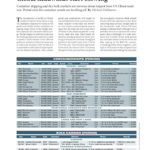Container shipping and dry bulk markets are nervous about impact from US-China trade war. Period rates for container vessels are levelling off. By Michael Hollmann
The introduction of tariffs on 50 bn $ worth of imports from China to the US, retaliatory measures by China on[ds_preview] US goods and a likely further escalation are causing major jitters in the freight markets, especially for containers and dry cargo. The full impact on seaborne trade once the tariffs get imposed in early July is hard to predict. Trade volumes of the affected goods are unlikely to fall at the same rate as trade costs increase (+25% tariffs) as it is impossible to substitute all import products by domestic products. Also, certain goods and commodities will simply be sourced elsewhere from countries that remain »neutral« in the trade war. However, most analysts and economists seem to agree that the trade row will at least shave off some of the projected growth in seaborne trade this year. Paris-based Alphaliner already grasped the nettle, lowering its forecast for container throughput growth in the world’s ports from 5.3% to 4.5% this year. That would be significantly less than the forecast 5.8% in nominal fleet growth this year and thus compound the overcapacity situation which already forced a few liner operators to shut down some long-haul services. Freight rates in the transpacific trade (China-US) have already weakened lately although this is probably more due to general slot overcapacity than a harbinger of a trade slowdown due to tariffs. So far, trade growth has remained robust as borne out by the May reading of the RWI/ISL container handling index which surged to a new high of 136.6 points in May (original value not seasonally and working-day adjusted).
A decline in traffic growth as from July would seriously harm ocean carriers’ efforts to restore freight rates which are lagging expectations this year. Rate levels picked up at the start of June as general rate increases and emergency bunker surcharges took effect. However, they quickly eroded in the following weeks. Major financial losses could be looming for container lines if the price situation does not improve. Route capacities would have to be slashed and charter vessels returned to their owners, undermining hire rates and earnings levels for tramp vessels.
Fortunately for shipowners, tonnage availability in the charter market has been very tight for many months so rate levels will not fall over a cliff if gradually more ships are coming into prompt positions. Last month still saw modest improvements in charter rates especially for panamax and traditional post-panamax vessels. The New ConTex increased by 2.4%. However, as from early/mid June brokers noticed more downward pressure on rates in certain sectors, especially in the smaller feeder classes below 2,000TEU which have seen a rebound in idle ships to 70 units – 60 of them tramp-owned, according to Alphaliner’s latest count. Of note, the gearless 2,700/2,800TEU segment, which had been of the strongest sectors throughout the last 12 months, also registered growing headwinds. London broker Howe Robinson marked period rates for 2,800TEU vessels down by 2.4% on 20 June.
In the feeder sectors, fixing activity continued to ease off in all major markets, particularly in North Europe where Maersk/Seago reportedly redelivered a number of ships as it phases in its own new 3,600TEU feeder vessels. Geared 1,100TEU vessels in Asia have been struggling as well lately, trying to prevent rate levels from slipping below 8,000$/day. With the summer holiday season approaching, the prospect of a recovery in the short term looks slim. Shipowners so far expected momentum to pick up after the summer break, it remains to be seen whether the trade war will thwart a post-summer upturn.
In the dry cargo market, capesize and panamax rates staged a bit of an unexpected rally in the first half of June driven to a large extent by additional cargoes and tonnage shortages in the Atlantic, however the market has been softening since then. China’s retaliatory tariffs against US goods are concentrated on agricultural products such as soybeans, corn and wheat which represent a major business especially for supramax and for panamax bulk carriers. In particular, a decline in the 33 million t soybean trade per annum could prove painful for shipowners. The question is whether Chinese buyers will simply reduce purchasing volumes and star destocking their supplies or whether they will shift sourcing to other markets such as Brazil if enough export volume is available there.
For the smaller geared bulkers – supramaxes and handies – the 25% tariffs on steels and aluminium into the US since 1 June pose an additional threat. US Census Bureau data shows that US steel imports fell sharply to 2.7mill. t already in May, from 3.4mill. t in April. According to London shipbroker SSY, a slowdown in steel volumes was the main factor that caused supramax spot earnings on the Europe-US route to drop below 7,000 $/day for the first time since February.
Michael Hollmann
















